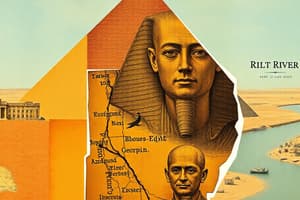Podcast
Questions and Answers
What role did the Nile River play in the Egyptian economy?
What role did the Nile River play in the Egyptian economy?
- It was the primary source of agricultural irrigation. (correct)
- It was a barrier against invading armies.
- It provided natural resources like minerals.
- It served as a trade route for foreign goods.
Which characteristic makes the eastern desert significant in Egyptian culture?
Which characteristic makes the eastern desert significant in Egyptian culture?
- It was a key area for mining operations.
- It symbolizes life and light due to the sunrise. (correct)
- It is associated with chaos and disorganization.
- It is known for its agricultural richness.
How did Akhenaten's Afonian Revolution affect religious beliefs in ancient Egypt?
How did Akhenaten's Afonian Revolution affect religious beliefs in ancient Egypt?
- It centralized worship around the sun as the sole god. (correct)
- It reintroduced worship of multiple deities.
- It emphasized the importance of the Nile in spiritual practices.
- It caused a decline in ritualistic practices.
What primary geographical feature provided protection to Egyptian civilization?
What primary geographical feature provided protection to Egyptian civilization?
What is the significance of the North Coast of Egypt?
What is the significance of the North Coast of Egypt?
Which civilization is believed to have begun around 3000 BC alongside Egypt?
Which civilization is believed to have begun around 3000 BC alongside Egypt?
What does the term 'Dört' refer to regarding Egyptian landscapes?
What does the term 'Dört' refer to regarding Egyptian landscapes?
What is the significance of granite stones in the Nile's southern region?
What is the significance of granite stones in the Nile's southern region?
Flashcards
Egyptian Trip 590 BC
Egyptian Trip 590 BC
A cruise around the Red and Mediterranean Seas, documented by Herodotus.
Nile River
Nile River
The major river of Egypt, crucial for agriculture and life.
Egyptian Desert
Egyptian Desert
A dangerous region, containing threats such as predators and invaders.
Akhenaten's Revolution
Akhenaten's Revolution
Signup and view all the flashcards
Egyptian Economy
Egyptian Economy
Signup and view all the flashcards
Levant
Levant
Signup and view all the flashcards
Prehistoric Egypt
Prehistoric Egypt
Signup and view all the flashcards
Mesopotamia
Mesopotamia
Signup and view all the flashcards
Sesostris's Canal
Sesostris's Canal
Signup and view all the flashcards
Egyptian Oasis
Egyptian Oasis
Signup and view all the flashcards
Study Notes
Egyptian Trip
- Egyptians traveled extensively, around 5000 BC
- Historical sources like Herodotus provide details about the trip
- The journey connected the Red Sea and Mediterranean Sea.
- Canal built by Sesostris around 5000 BC
Egyptian Topography
- Egypt displays varied geographical features, including various areas of deserts.
- Egypt's geography includes deserts, the Nile River, and coastlines
Egyptian Economy
- Egypt's economy was agrarian and based on the Nile and animals
- Evidence on temple walls illustrates daily life and agricultural practices in ancient Egypt.
- This confirms Egypt's reliance on agriculture for survival.
Akhenaten's Revolution
- Akhenaten instigated a religious revolution centered on the sun
- This transformed the belief system that revolved around life, death, and daily existence.
Geographical Composition of Egypt
-
- Northern Coast: Mediterranean Sea
-
- Eastern Coast: Red Sea
- 3-4. Western and Eastern deserts (Libyan, Arabian)
-
- Nile River running through the South
- Granite stones hindered foreign ships along the Nile
- Geographical features provided protection for Egypt from various external threats
Deserts in Egypt
- The desert is referred to as "the red desert".
- The presence of predatory animals and foreign invaders made the desert a significant danger for Egypt
- The east and west deserts signified chaos and were a source of difficulty for trade and travel.
- Sunrise, representing life, and sunset, representing death, were associated with the deserts and were vital in daily life
Nile River and Valley
- Rich agricultural land exists along the valley of the Nile River
- The fertile land was known as the "black land".
- The area provided stability and permanence for the civilization
- The Delta (the northern part of the Nile) is the fourth letter of the Greek alphabet, inverted in usage
- The Nile played a key role in ancient Egypt's water source and agricultural activities
Timeline of Early Egypt
- Egypt's history, starting about 3000 BC, saw its civilization emerge from prehistoric societies
- Civilization emerged around 3000 BC, starting after the prehistoric era, following a change in rainfall patterns that had impacted settlements and food collection
- The period before writing involved the descent of humans from the gods
- Study will be of civilizations from 3000 BC to 332 BC, focusing on the Egyptian dynasty through to the Greek period
Studying That Suits You
Use AI to generate personalized quizzes and flashcards to suit your learning preferences.




